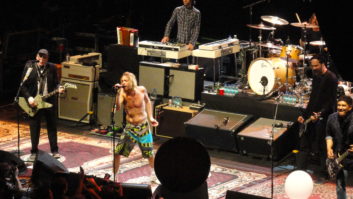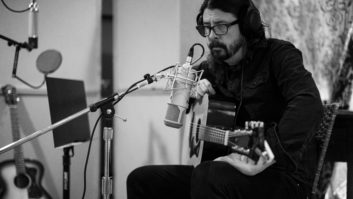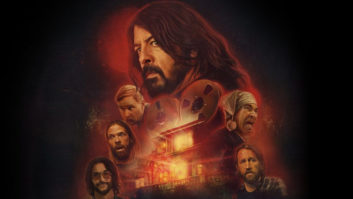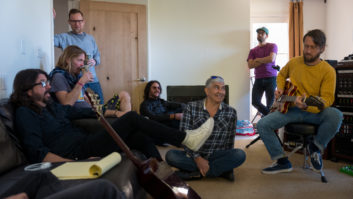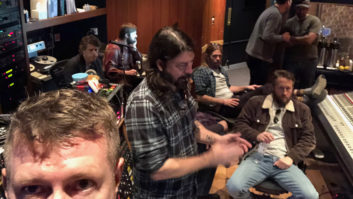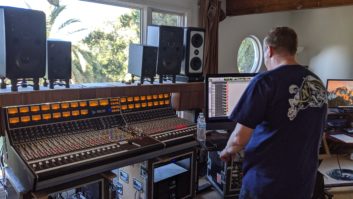Foo Fighters’ Dave Grohl, seen here belting into a Sennheiser MD 431, has spent the summer touring North America having to perform onstage from a mobile throne, after breaking his leg during a June concert.QUEENS NY—The Foo Fighters’ summer tour put the “leg” in “legendary” this year—and that was before it even started. During a June 12 concert in Gothenburg, Sweden, band leader Dave Grohl fell off the stage, and though he finished out the show in a chair while being attended to by a medic, it turned out he’d broken his leg, requiring a half-dozen metal pins to be surgically inserted. Despite this, the band’s 43-date North American tour kicked off on schedule July 4 and is currently blazing a trail through stadiums and arenas with Grohl seated atop a giant, track-mounted throne at centerstage that props up the singer’s leg and keeps him off his feet.

While the mobile throne undoubtedly presents a challenge to Grohl, who has to rock a crowd while sitting down, it actually makes life easier for the tour’s audio crew, in part because it has less to look after. “When Dave broke his leg, we had to do away with the B-stage stuff, so this is only half the system,” said monitor engineer Ian Beverage, standing stageside at New York’s CitiField Stadium. “When it’s the full A-stage/B-stage show, it’s almost hard to fit on my Midas Pro9.”
Bryan Worthen, the band’s FOH engineer of 13 years, likewise has no problems with the theatrical throne, as its back is perforated so that the roar of the audience doesn’t reflect into Grohl’s vocal mic. “If anything,” he added wryly, “it keeps Dave on the microphone instead of running around.”
Even without a B-stage, the tour is still carrying a massive sound system provided by Delicate Productions (Camarillo, CA), the band’s longtime audio provider. Helping cover entire stadiums with an earful of audio is a sizable L-Acoustics system comprised of K2 and K1 boxes, with the latter provided in partnership with Winston-Salem, NC’s Special Event Services. Crew chief Steve Walsh explained, “We’re carrying a K1/K2 PA, so in stadiums, the main hangs are 16 boxes of K1 with 4 boxes of K2 on downfill. Then we’ve got 20 boxes of K2 from side hangs, and 20 boxes of K2 for our delay towers. SB 28s go across the front of the stage, plus some KARAs and ARCs for front fill, so it’s a pretty big, rockin’ system actually.”
All of that is connected by a Dante network designed and overseen by system engineer Philip Reynolds, that includes a DiGiCo MOD-SD-Dante I/O card on the DiGiCo SD5 console at FOH, a quartet of Lake LM44 units for processing and EQ, and a selection of Focusrite RedNet D16 I/Os routing to the various clusters. “I was one of the first people to build a rig out of the Focusrite RedNet series and since then, I’ve loved the products,” said Reynolds. “I’ve never had an issue, whatsoever; it was awesome to be able to build a network so robust and so easy to maneuver channels around.”
While the system is intended to provide a hi-fi touch to every show, when Worthen is behind his DiGiCo desk at FOH, he’s not concerned with giving a song that ‘in the studio’ sound: “The new ones, they play them great, so it’s pretty easy to make it sound as good and bigger than the record—but the old songs, you have to make them sound like people have interpreted them in their own brains.”
Given Grohl’s penchant for analog consoles in the studio—a position thoroughly put forth a few years ago in his documentary Sound City—it might almost be a surprise to find a DiGiCo desk at FOH, but aside from the Dante aspects, the digital features are largely an afterthought. “I use that console like an analog console; I don’t use it like a digital,” said Worthen. “I don’t do snapshots, presets or any of that stuff—I like to mix.”
FOH engineer Bryan Worthen treats his DiGiCo SD5 console like an analog desk, eschewing snapshots and so forth, as he sends his mix to the massive L-Acoustics K1/K2 PA, seen here in New York’s CitiField Stadium. With the band supporting its 2014 Sonic Highways album, Worthen gets that opportunity to dig into the mix with an album track, “Outside,” which was recorded during the Los Angeles episode of the HBO documentary series that accompanied the album’s release. “It has a lot of space,” he said. “It’s a super driving song, very dynamic and it’s got a lot of weird sounds that I can toy with coming from the keyboard player and Dave’s guitar.”

As the band has endorsed Sennheiser for a number of years, most of the stage is captured with the German manufacturer’s mics, which is fine with Worthen; as he pointed out, it allows him to use his favorite snare-miking arrangement: “My top is an e 905 and my snare bottom is a condenser e 614. I use that combination on Foos, Godsmack and Limp Bizkit—every band I do. A lot of people think ‘a condenser on a snare bottom?’ But it’s rad; I love it.” Another mic of note on stage is the Sennheiser MD 431 that captures Grohl’s vocals. “That mic does really well for him,” said Worthen, “because it’s a 421 capsule within a handheld body. Dave puts enough volume out of his mouth that it could really be any mic for me, but Ian can get that one extremely loud in the monitors with little effect.”
Those monitors are everywhere on stage, too. Only one bandmember opts for in-ears (JH Audio ear pieces on a Sennheiser EM 2050 transmitter/receiver system), so Beverage sends a dozen mixes through d&b audiotechnik M2 wedges and Martin Audio sidefills, along with 10 in-ear mixes for techs.
In Beverage’s monitorworld, the name of the game is “simple.” The Scottish engineer, who’s mixed Grohl since Nirvana’s 1990 UK tour, keeps all the processing inside his Midas Pro9: “You can bring a whole bunch of outboard stuff and drag it around with you, but…I’d rather have a simple set-up and rely on an inherently good-sounding console. There’s a lot of EQ and processing, but it’s all done with the tools available on-board. That’s how I personally like to do it.”
Even if the set-up is simplified, Beverage still faces a considerable task every night, providing a sense of spatial separation between instruments: “The hard thing about the Foo Fighters is you have three guitars on stage that are distorted a lot of the time. If you have a mono box sitting on the floor and you put two really distorted guitars in it, you’re never going to tell which one’s which unless they’re dramatically different in tone—and these are not. The only way I can give them any distinction is to have a directional factor, so everybody hears other people’s stuff coming from different places. That’s planned out across the stage in the mixes so that if a guy’s on stage left, he’ll hear Dave’s guitar from the stage left sidefill but his own guitar from his own wedge, giving it that spatial difference.
“I always say, if you can maximize the ratio of music-to-noise, you’re doing pretty good,” he laughed, “and that’s what we’re trying to do.”
Delicate Productions
Delicate.com
L-Acoustics
l-acoustics.com
DiGiCo
Digico.biz
Focusrite
Focusrite.com
